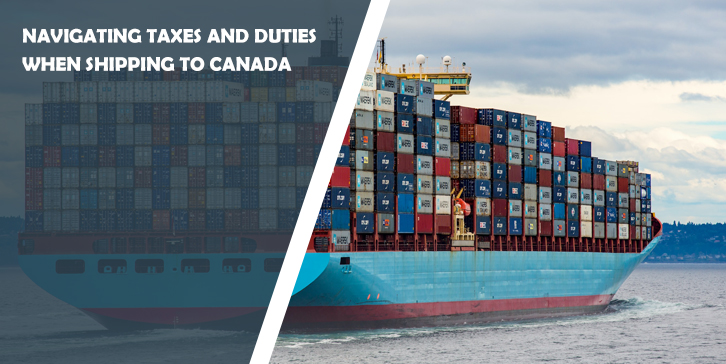Shipping to Canada can be a great opportunity for businesses looking to expand their customer base. As businesses continue to expand their global reach, shipping to Canada has become an increasingly attractive option. With a population of over 38 million people and a strong economy, Canada offers a large and lucrative market for businesses of all sizes. However, as with any international shipping endeavor, navigating taxes and duties can be a complex process that requires careful consideration. In this article, we will explore the taxes and duties you need to consider when shipping to Canada and how to navigate them, so you can successfully expand your business into the Canadian market.

Understanding Canadian Value-Added Taxes: GST, PST, and HST
The first thing to understand is that Canada has a value-added tax called the Goods and Services Tax (GST), which is applied to most goods and services in Canada. The current rate of GST is 5%. In addition to GST, certain provinces have a provincial sales tax (PST), which varies by province. Some provinces also have a harmonized sales tax (HST), which combines both GST and PST. The current HST rates range from 13% to 15%, depending on the province.
When shipping goods to Canada, you will need to determine whether your goods are subject to any duties or taxes. The Canada Border Services Agency (CBSA) is responsible for assessing and collecting duties and taxes on imported goods. The CBSA uses the Harmonized System (HS) to classify goods and determine the applicable duty rates.
Duties are calculated based on the value of the goods, as well as the country of origin. The duty rates vary depending on the HS code and the country of origin. For example, the duty rate for clothing from the United States is generally 16.5%, while the duty rate for clothing from China is generally 17%. The HS code, or Harmonized System code, is a standardized system used to classify goods for international trade. The HS code is used to determine the applicable duty rates, as well as any other fees or taxes that may apply. It’s important to accurately determine the HS code for your goods to ensure that the correct duty rates are applied.
In addition to the HS code, the country of origin can also impact the duty rates. For example, the duty rate for clothing from the United States is generally 16.5%, while the duty rate for clothing from China is generally 17%. This difference in duty rates can impact the cost of importing goods and should be carefully considered when planning your shipments.
It’s important to note that there are some exceptions to duty rates, such as the North American Free Trade Agreement (NAFTA), which eliminates duties on most goods traded between Canada, the United States, and Mexico. However, with the recent implementation of the United States-Mexico-Canada Agreement (USMCA), there are some changes to duty rates that businesses should be aware of.
Navigating duties and taxes when shipping to Canada can be a complex process, but understanding the applicable rates and fees is essential to the success of your business. By doing your research and working with experienced professionals, you can ensure that your shipments are compliant with all regulations and requirements, and that you are able to successfully expand your business into the Canadian market.
In addition to duties, imported goods may also be subject to other fees, such as excise taxes and anti-dumping duties. Excise taxes are applied to certain goods, such as tobacco and alcohol. Anti-dumping duties are applied when imported goods are sold at a lower price than the domestic market, which can harm domestic industries.
To navigate taxes and duties when shipping to Canada, it’s important to do your research and understand the applicable rates and fees. You can use the CBSA’s online tool, the Customs Tariff, to determine the HS code and applicable duty rates for your goods. You should also consider working with a customs broker or freight forwarder who can help you navigate the complex process of importing goods into Canada.

Compliance with Documentation and Permit Requirements
When shipping to Canada, it’s also important to ensure that you comply with all regulations and documentation requirements. You will need to provide a commercial invoice, bill of lading, and any necessary permits or licenses. Failure to comply with these requirements can result in delays or penalties.
Conclusion
In conclusion, shipping to Canada can be a valuable opportunity for businesses looking to expand their customer base, but it requires careful consideration of taxes and duties. To navigate this complex process, it’s important to do your research, work with experienced professionals, and ensure compliance with regulations. By taking these steps, you can successfully expand your business into the Canadian market and achieve long-term success. Remember, the key to success when shipping to Canada is to stay informed, plan ahead, and be diligent in your efforts to comply with all regulations and requirements.





Comments are closed.